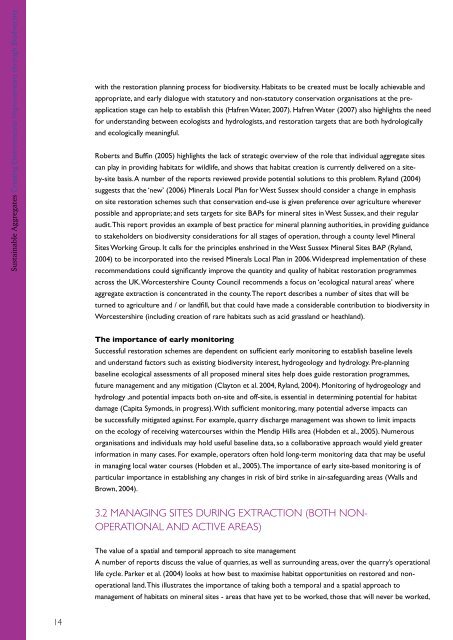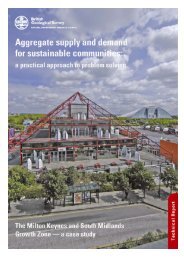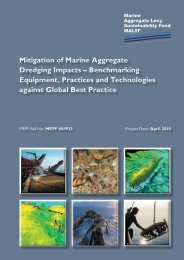creating environmental improvements through biodiversity
creating environmental improvements through biodiversity
creating environmental improvements through biodiversity
You also want an ePaper? Increase the reach of your titles
YUMPU automatically turns print PDFs into web optimized ePapers that Google loves.
Sustainable Aggregates Creating Environmental Improvements <strong>through</strong> Biodiversity<br />
with the restoration planning process for <strong>biodiversity</strong>. Habitats to be created must be locally achievable and<br />
appropriate, and early dialogue with statutory and non-statutory conservation organisations at the preapplication<br />
stage can help to establish this (Hafren Water, 2007). Hafren Water (2007) also highlights the need<br />
for understanding between ecologists and hydrologists, and restoration targets that are both hydrologically<br />
and ecologically meaningful.<br />
Roberts and Buffin (2005) highlights the lack of strategic overview of the role that individual aggregate sites<br />
can play in providing habitats for wildlife, and shows that habitat creation is currently delivered on a siteby-site<br />
basis. A number of the reports reviewed provide potential solutions to this problem. Ryland (2004)<br />
suggests that the ‘new’ (2006) Minerals Local Plan for West Sussex should consider a change in emphasis<br />
on site restoration schemes such that conservation end-use is given preference over agriculture wherever<br />
possible and appropriate; and sets targets for site BAPs for mineral sites in West Sussex, and their regular<br />
audit. This report provides an example of best practice for mineral planning authorities, in providing guidance<br />
to stakeholders on <strong>biodiversity</strong> considerations for all stages of operation, <strong>through</strong> a county level Mineral<br />
Sites Working Group. It calls for the principles enshrined in the West Sussex Mineral Sites BAP (Ryland,<br />
2004) to be incorporated into the revised Minerals Local Plan in 2006. Widespread implementation of these<br />
recommendations could significantly improve the quantity and quality of habitat restoration programmes<br />
across the UK. Worcestershire County Council recommends a focus on ‘ecological natural areas’ where<br />
aggregate extraction is concentrated in the county. The report describes a number of sites that will be<br />
turned to agriculture and / or landfill, but that could have made a considerable contribution to <strong>biodiversity</strong> in<br />
Worcestershire (including creation of rare habitats such as acid grassland or heathland).<br />
The importance of early monitoring<br />
Successful restoration schemes are dependent on sufficient early monitoring to establish baseline levels<br />
and understand factors such as existing <strong>biodiversity</strong> interest, hydrogeology and hydrology. Pre-planning<br />
baseline ecological assessments of all proposed mineral sites help does guide restoration programmes,<br />
future management and any mitigation (Clayton et al. 2004, Ryland, 2004). Monitoring of hydrogeology and<br />
hydrology ,and potential impacts both on-site and off-site, is essential in determining potential for habitat<br />
damage (Capita Symonds, in progress). With sufficient monitoring, many potential adverse impacts can<br />
be successfully mitigated against. For example, quarry discharge management was shown to limit impacts<br />
on the ecology of receiving watercourses within the Mendip Hills area (Hobden et al., 2005). Numerous<br />
organisations and individuals may hold useful baseline data, so a collaborative approach would yield greater<br />
information in many cases. For example, operators often hold long-term monitoring data that may be useful<br />
in managing local water courses (Hobden et al., 2005). The importance of early site-based monitoring is of<br />
particular importance in establishing any changes in risk of bird strike in air-safeguarding areas (Walls and<br />
Brown, 2004).<br />
3.2 MANAGING SITES DURING EXTRACTION (BOTH NON-<br />
OPERATIONAL AND ACTIVE AREAS)<br />
The value of a spatial and temporal approach to site management<br />
A number of reports discuss the value of quarries, as well as surrounding areas, over the quarry’s operational<br />
life cycle. Parker et al. (2004) looks at how best to maximise habitat opportunities on restored and nonoperational<br />
land. This illustrates the importance of taking both a temporal and a spatial approach to<br />
management of habitats on mineral sites - areas that have yet to be worked, those that will never be worked,<br />
14

















